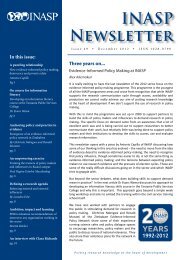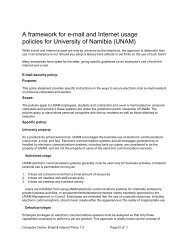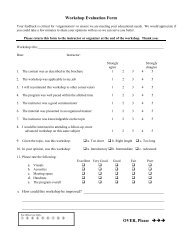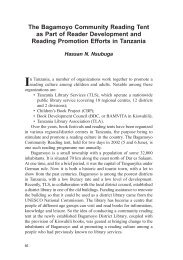What is the evidence on evidence-informed policy making? - INASP
What is the evidence on evidence-informed policy making? - INASP
What is the evidence on evidence-informed policy making? - INASP
You also want an ePaper? Increase the reach of your titles
YUMPU automatically turns print PDFs into web optimized ePapers that Google loves.
Three presentati<strong>on</strong>s c<strong>on</strong>cerned alternative approaches that can be used in order to<br />
c<strong>on</strong>nect <strong>policy</strong> makers, researchers and Civil Society Organ<str<strong>on</strong>g>is</str<strong>on</strong>g>ati<strong>on</strong>s. Julia D’Agostino<br />
(Argentina) d<str<strong>on</strong>g>is</str<strong>on</strong>g>cussed <str<strong>on</strong>g>the</str<strong>on</strong>g> experiences gained over <str<strong>on</strong>g>the</str<strong>on</strong>g> years by <str<strong>on</strong>g>the</str<strong>on</strong>g> Global<br />
Development Network (GDNet) and <str<strong>on</strong>g>the</str<strong>on</strong>g> Center for <str<strong>on</strong>g>the</str<strong>on</strong>g> Implementati<strong>on</strong> of Public<br />
Policies Promoting Equity and Growth (CIPPEC) working with diverse think tanks,<br />
research centres, universities and experts in Latin America, Africa and Asia. Julia<br />
especially highlighted <str<strong>on</strong>g>the</str<strong>on</strong>g> need to generate ‘more synergies’ between different<br />
platforms, to promote <str<strong>on</strong>g>the</str<strong>on</strong>g> use of <str<strong>on</strong>g>evidence</str<strong>on</strong>g> am<strong>on</strong>g <strong>policy</strong> makers, to streng<str<strong>on</strong>g>the</str<strong>on</strong>g>n<br />
researchers’ influencing skills, and to achieve sustainability of linkages.<br />
Michael O’Dwyer (UK) presented an approach implemented by DFID to influence<br />
HIV <strong>policy</strong> for marginal<str<strong>on</strong>g>is</str<strong>on</strong>g>ed groups in Pak<str<strong>on</strong>g>is</str<strong>on</strong>g>tan (Hawkes & Zaheer 2012). Michael<br />
recommended <str<strong>on</strong>g>the</str<strong>on</strong>g> need for involvement of those who were most affected by<br />
policies in advocacy efforts – for example in Pak<str<strong>on</strong>g>is</str<strong>on</strong>g>tan <str<strong>on</strong>g>the</str<strong>on</strong>g>y built <str<strong>on</strong>g>the</str<strong>on</strong>g> capacity of civil<br />
society organ<str<strong>on</strong>g>is</str<strong>on</strong>g>ati<strong>on</strong>s representing marginal<str<strong>on</strong>g>is</str<strong>on</strong>g>ed groups to demand <strong>policy</strong> change.<br />
He also acknowledged that real<str<strong>on</strong>g>is</str<strong>on</strong>g>tic expectati<strong>on</strong>s of research impact should be set –<br />
in particular when research <str<strong>on</strong>g>evidence</str<strong>on</strong>g> <str<strong>on</strong>g>is</str<strong>on</strong>g> ‘competing’ against str<strong>on</strong>g cultural or<br />
religious beliefs. Maria Bar<strong>on</strong> (Argentina) described <str<strong>on</strong>g>the</str<strong>on</strong>g> Fundaci<strong>on</strong> Directorio<br />
Leg<str<strong>on</strong>g>is</str<strong>on</strong>g>lativo’s approach in Argentina, aimed to build an area of c<strong>on</strong>structive dialogue<br />
between <strong>policy</strong> makers and CSOs. Maria calls for a space of informal d<str<strong>on</strong>g>is</str<strong>on</strong>g>cussi<strong>on</strong><br />
am<strong>on</strong>g formal stakeholders.<br />
The remaining presentati<strong>on</strong>s described how linkages and networks develop within<br />
different channels and in different c<strong>on</strong>texts. Hailemichael Taye Beyene (Ethiopia),<br />
whose research <str<strong>on</strong>g>is</str<strong>on</strong>g> still in progress, c<strong>on</strong>sidered <str<strong>on</strong>g>the</str<strong>on</strong>g> role of <str<strong>on</strong>g>evidence</str<strong>on</strong>g> in livestock <strong>policy</strong><br />
<strong>making</strong> in Ethiopia. Hailemichael’s preliminary findings are that <str<strong>on</strong>g>the</str<strong>on</strong>g> linkages am<strong>on</strong>g<br />
actors in <str<strong>on</strong>g>the</str<strong>on</strong>g> livestock development <strong>policy</strong> process in Ethiopia are not str<strong>on</strong>g and<br />
that use of <str<strong>on</strong>g>evidence</str<strong>on</strong>g> in <str<strong>on</strong>g>the</str<strong>on</strong>g> <strong>policy</strong> <strong>making</strong> process <str<strong>on</strong>g>is</str<strong>on</strong>g> at an infant stage. Nnenna<br />
Nwakanma (Nigeria), by analysing <str<strong>on</strong>g>the</str<strong>on</strong>g> c<strong>on</strong>text of Ivory Coast, highlighted how social<br />
media can influence EIPM and c<strong>on</strong>stitute a platform for <str<strong>on</strong>g>the</str<strong>on</strong>g> acti<strong>on</strong> of an active<br />
digital citizenship. Her presentati<strong>on</strong> explored <str<strong>on</strong>g>the</str<strong>on</strong>g> profile of <str<strong>on</strong>g>the</str<strong>on</strong>g>se digital-citizens, <str<strong>on</strong>g>the</str<strong>on</strong>g>ir<br />
<strong>policy</strong> <str<strong>on</strong>g>is</str<strong>on</strong>g>sues and how <str<strong>on</strong>g>the</str<strong>on</strong>g>ir acti<strong>on</strong>s have become a major motivator for <strong>policy</strong><br />
Page 8








